The Monarch Butterfly is an animal we find here at our prarie. The Latin name for the Monarch Butterfly is Danaus Plexippus. The physical characteristics of the Monarch Butterfly are normally the color of orange, red or yellow. The length of the Monarch Butterfly are 2 1/2 to 3 inches. The Monarch Butterflys fly to Mexico or the Pacific Coast of California after they hatch and live on a certain kind of tree. The Monarch butterfly start in an egg, changes to a larva, then to an pupa and finally ends as an adult Monarch Butterfly.
Thursday, June 3, 2010
Touch me not
It grows in long grass prairie's. It grows to 2 to 5 feet tall. If you touch it a seed will shoot out of a pocket. It's leafs are 3 inches.
Purple prairie(Dalea purpurea)
Purple prairie is in a long grass prairie. It is .25 inches long. It has 4 pedals.this ranges from north to sothern usa.
milk weed
Milkweed is the common name for a group of plants that belong to the Asclepias genus. This genus of plants is named after Asclepius, the god of medicine and healing in ancient Greek mythology. Milkweeds have a long history of being used for medicinal purposes because of the cardiac glycosides found in their tissue.
Milkweed is the host plant for the monarch butterfly. As the monarch larva consumes the milkweed leaves, it also retains the cardiac glycosides making the monarch toxic to predators.
There are over 100 species of milkweed in North America and the diversity of foliage and flower color is quite amazing. View our Milkweed Photo Gallery to see photographs of several different species of milkweed. All milkweeds are herbaceous perennials, meaning they live for more than two years. In fact, most milkweeds will live for several years if cared for properly. Since some milkweeds can't handle freezing temperatures, there are two classifications we like to divide them into:
Hardy Perennial - These milkweed species can survive below freezing temperatures in any zone in the United States. They go dormant in the winter months and return each spring.
Frost Tender Perennial - A few milkweeds fall into this category. You can still grow them anywhere in the United States. However, if you live in a zone that falls between 1 and 9, the plants will die in the winter and you will have to replant from seed in the spring. In zones 10 - 11, these milkweed species will grow year round
Milkweed is the host plant for the monarch butterfly. As the monarch larva consumes the milkweed leaves, it also retains the cardiac glycosides making the monarch toxic to predators.
There are over 100 species of milkweed in North America and the diversity of foliage and flower color is quite amazing. View our Milkweed Photo Gallery to see photographs of several different species of milkweed. All milkweeds are herbaceous perennials, meaning they live for more than two years. In fact, most milkweeds will live for several years if cared for properly. Since some milkweeds can't handle freezing temperatures, there are two classifications we like to divide them into:
Hardy Perennial - These milkweed species can survive below freezing temperatures in any zone in the United States. They go dormant in the winter months and return each spring.
Frost Tender Perennial - A few milkweeds fall into this category. You can still grow them anywhere in the United States. However, if you live in a zone that falls between 1 and 9, the plants will die in the winter and you will have to replant from seed in the spring. In zones 10 - 11, these milkweed species will grow year round
Subscribe to:
Comments (Atom)



